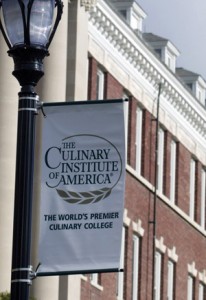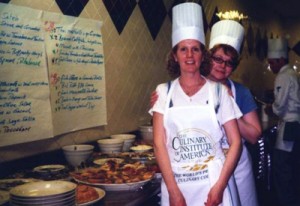 In the last five days of 2010, we are going to count down five of our favorite stories from some of our favorite authors in our first year, starting with Diana Lawrence’s marvelous Kiss the Cook. This story, and all the stories featured in our last week, can be found in The Best of the Press, Volume I, available in print or as an eBook for all platforms.
In the last five days of 2010, we are going to count down five of our favorite stories from some of our favorite authors in our first year, starting with Diana Lawrence’s marvelous Kiss the Cook. This story, and all the stories featured in our last week, can be found in The Best of the Press, Volume I, available in print or as an eBook for all platforms.
Kiss the Cook by Diana Lawrence
I run with a cooking crowd.
My friends make their own sushi, consider ile flottante and crème brûlée to be comfort foods, wax rhapsodic about the merits of artisanal cheeses, and subscribe to magazines like Saveur and Cook’s Illustrated. We know where to buy the best local grass-fed beef, the cheapest case of Prosecco, the perfect poached pears (in saffron and white wine sauce, of course), and the freshest lemongrass. When Santa visits our houses at Christmas, he brings Silpat mats, ramekins, and Japanese cleavers.

Battered by six months of winter and surrounded by farmers markets and organic everything, we must surely be forgiven for our food obsession. What else is there to do in Vermont but eat, drink, or ski? Years of themed dinner parties, bake sales, Fourth of July picnics, and cookie swaps have left us feeling like kitchen veterans, and maybe just a smidge overconfident at the stove. For those of us who’ve racked up dozens of birthday extravaganzas and Thanksgiving platters, a one-day class at the renowned Culinary Institute of America seems like the perfect learning vacation.
It all began pleasantly enough. It was summer, a time when a road trip to Hyde Park, New York is almost appealing. I’d received the CIA catalog in the mail and was drawn to a class on hors d’œuvres called First Impressions that seemed useful and fun. Perfect your talents and impress your guests, crowed the literature. I was in! My friends Mona and Jeff obtained the necessary spousal permission to join me and the fees were paid. We were enthusiastic about the unusual cooking opportunity, and excited to be leaving our little town for the world-class instruction of the culinary institute. We piled into my station wagon on a Friday afternoon and made our way out of state, shrieking like college kids and eating junk food as we drove. Chips with French onion dip, Hostess Twinkies, root beer, beef jerky, and Milk Duds gave a wild edge to our middle-aged adventure. We were ready to throw convention out the window. We were—if the brochure was anything to go by—on our way to party success!
Fifteen eager amateurs joined Chef Martin Frei in the classroom the next morning, happily sprawled on kitchen stools around the central oven for individual introductions and a thorough review of each recipe and ingredient we’d be using that day. He gave us detailed tips on timing, service, and recipe substitutions; reflected on the art of hospitality; and suggested uses for unusual elements like pomegranate syrup (“a sublime replacement for grenadine”) or fiori di Sicilia (“much better than plain old vanilla in cakes”). His daughter was attending Middlebury College in Vermont, he said, and so he was very happy to have the three of us in his class.
We moved giddily into small groups, set our menus on the countertops at our stations beside the glasses of shiny tasting spoons and stacks of mise en place cups, and slipped our new CIA aprons over our heads. Each group would produce a set of five hors d’œuvres, to be ready for the table by two o’clock in the afternoon. We were all required to participate in the cleanup and the plating, but we also got to enjoy the fruits of our labors at the end of the session. Two young CIA students were to float around the classroom, available to assist us if we had questions or needed information. With fresh clean towels tucked into our sashes (never use them to touch the food!) and bright sharp knives in our hands (never let the tip of the blade leave the chopping board!), we were ready to go.

- The author (in blue) with friend and fellow student Mona
The challenge of making your way around a strange kitchen is compounded in a professional environment. I quickly realized that the oven had no temperature dial. It was set at approximately 350 degrees, and since there were no timers to be found, all of the students had to rely on instinct, regular observation, and an acute sense of smell to avoid charring their carefully constructed efforts. The pot filler faucets delivered only boiling hot water (a painful lesson that I learned almost immediately), the extra utensils and cookware were stored at the other end of the classroom far away from the action, and all of the spices had to be ground, grated, or chopped by hand.
Some of the regular culinary arts students stopped and peered curiously at us through the window of the kitchen door as they moved down the hallway, laughing good-naturedly as we burned ourselves, attempted unsuccessfully to slice an onion properly, or dropped our tongs and baking sheets in a clatter on the floor. What began as a leisurely cooking session gradually turned into a frenzied, time-pressured performance like we had never known. Five hours had originally seemed to be a generous window for preparing a relatively small number of recipes. After all, there were three of us. How difficult could it be? From soaking the wooden skewers for Hunan satay to dicing the confetti for the tropical mango salsa, we soon came to realize the true talent in the CIA kitchen. It was the students.
The assistants who at first had seemed superfluous and a little annoying quickly became gods. They knew all of the shortcuts, took on parts of our recipes, did everything better, and ran to fetch missing items as we raced against time. They turned into teachers and confidants, and shared a few juicy tidbits about the chefs and the curriculum at the school. From them I learned why people devote their lives to the culinary arts: to use their tremendous creativity, for the opportunity to nurture others, to grow the family business or start one of their own.
While we struggled to execute novel dishes in tandem, Chef Frei moved among us observing and correcting our techniques. From the adjacent station, Mona sincerely offered me her children in exchange for assistance slicing four bowls of unpitted olives. I mistakenly cut my apricots vertically instead of horizontally and had to start again, quietly sobbing. Horrified, I watched the fresh clean towels hanging on my fellow classmates’ aprons become hand wipes, sweat rags, and then oven mitts, bacteria be damned.
As soon as you were right in the middle of blanching a dozen tomatoes over a bubbling stockpot or brushing an egg wash onto a pastry-wrapped wheel of Brie, Chef Frei would inevitably decide to conduct an impromptu cooking lesson and we’d all drop everything and beetle around the ovens to catch the instruction wherever it was happening. Here was the best way to chop a clove of garlic, a demonstration in the art of preparing mozzarella di bufala, or tips for working effectively with temperamental phyllo dough. Then it was back to our stations to resume our battle with the clock.
As the end of the class approached, the pace grew more intense, the atmosphere more reckless. Our backs ached, our feet hurt, and our hands were slippery with juice and sweat. Traumatized by the endless list of ingredients in his stuffed grape leaves recipe, Jeff dropped his normally calm demeanor and began hollering for his missing bowl of gremolata sauce (which I had accidentally emptied into the sink). Desperately, he reached for the parsley and lemon and began to recreate the missing element. Mona and I shook our heads in pity as he whisked the olive oil, finishing just in time for the plating to begin.
Gradually, magically, every dish was transferred to an appropriate serving platter or bowl and covered rapidly with plastic wrap. The pots were hauled down to the dishwashing area and we began scrubbing, drying, and hanging every item we had used, pumping cups of antibacterial soap into the sink and cutting our throbbing hands on the graters and utensils. At last, dirty and exhausted, we walked silently down the hall to the nearby cafeteria, melted into our seats at the long, formal tables, uncorked several bottles of chilled white New York state wine, and began passing around the impressive food we had created. It was delicious.

Had we really made all of these wonderful things? We were staggered by the miracle that had just taken place. Professional cooking requires the precision of a pit stop, the endurance of a racehorse, and the timing of a Broadway production. Never again would we call ourselves anything but neophytes. It was clear where the credit was due. I toasted my student assistant.
After thanking Chef Frei, packing up a few excellent leftovers, and making our way through the Craig Claiborne Bookstore, we wandered out to our car. We had booked dinner at one of the school’s outstanding restaurants, American Bounty, but our reservation was not until seven o’clock, and we were simply beyond exhaustion. Like 19-year-old college students, we collapsed in the car and under the trees, sleeping like vagrants in the attempt to revive ourselves for the meal ahead. Our fatigue was shocking. Did we not have families, run businesses, manage households, and volunteer in our communities? We marveled that five hours of athletic food preparation and a nice full stomach had the capacity to bring us to our knees. Eventually we roused ourselves, splashed water on our faces, and changed clothes. We felt as though we had run a marathon.
Later in the restaurant, we tasted some of the best food of our lives. We watched through observation windows as college seniors prepared delicately caramelized bananas and folded them into paper-thin, sugar-dusted crêpes. We ate delicate soup trios and wild poached salmon that vibrated with fresh, perfectly cooked flavors. We nibbled cheese and drank wine that made every other meal seem dull and tasteless. None of it was prepared by us, and it never would be.
But rather than leave the CIA with our tails between our legs, we drove home on a cloud of accomplishment, exhilaration, and appreciation. We now knew what a gift it truly was to be able to create the perfect Pavlova or exquisite crudités. We felt we finally understood the effort, the conviction, and the talent that good cooking requires. Rather than discourage us, it reaffirmed our love of the eating experience: food is one of the most intimate ways in which we connect with one another, and to make something special for someone else to enjoy is a ritual that makes friends of strangers. To share that aptitude with another person is to keep humanity moving forward. Our respect for the skillful preparation of the most humble dish grew tenfold.
Next year we plan to go again to the Culinary Institute of America, but this time we’re thinking of taking a class that’s a little less taxing. I’ve been reviewing this year’s catalog, running through the options for desserts, meats, soups, buffets, and breads. I believe the low-impact, advanced wine-tasting course will be just the thing.
 Diana Lawrence is communications director for Alumni Relations at Dartmouth College, where she is completing a master’s degree in creative writing. Diana writes, drinks, and throws parties with her husband Rod in an old brick house in Grafton, Vermont.
Diana Lawrence is communications director for Alumni Relations at Dartmouth College, where she is completing a master’s degree in creative writing. Diana writes, drinks, and throws parties with her husband Rod in an old brick house in Grafton, Vermont.

